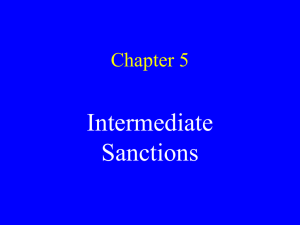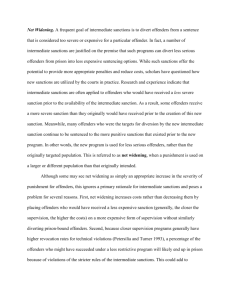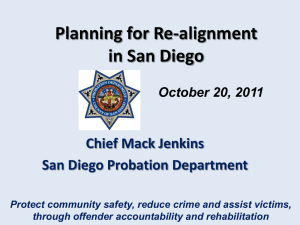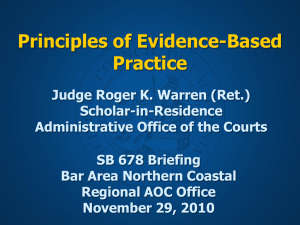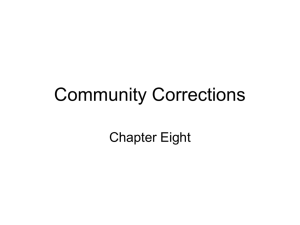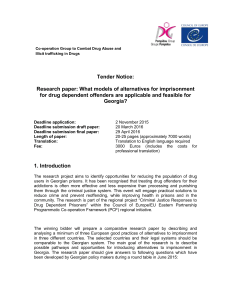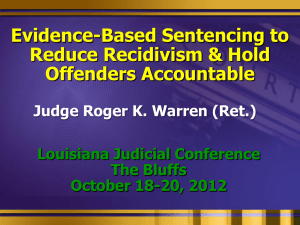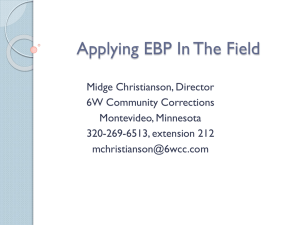Complete presentation Ioan Durnescu
advertisement
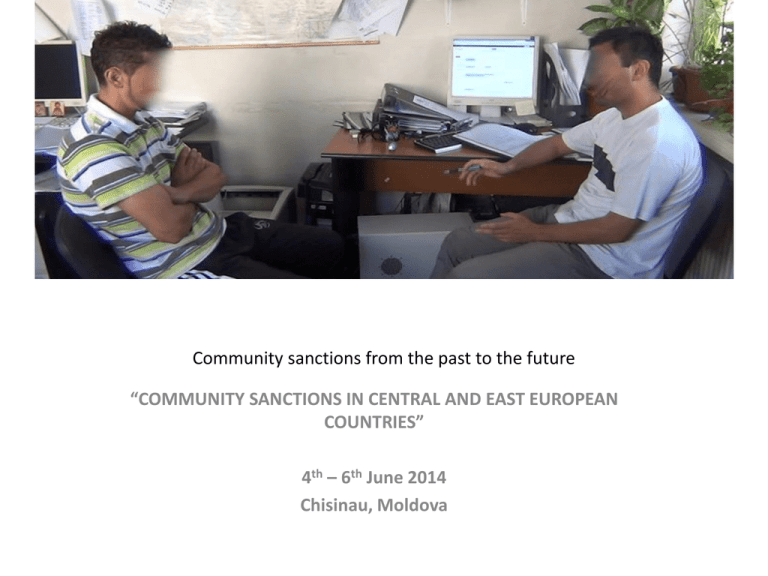
Community sanctions from the past to the future “COMMUNITY SANCTIONS IN CENTRAL AND EAST EUROPEAN COUNTRIES” 4th – 6th June 2014 Chisinau, Moldova Short definition Custody Community sanctions (from Bottoms, Gelsthorpe and Rex, 2001) Other nominal penalties (e.g. fine) I. Origins – Community sanctions as privileges • community sanctions find their origins in the practices of recognizance (or ‘binding them over’) and surety system of bail release (Harris, 1995) – little or no supervision • As elements of humanity and practical justice • Offenders – ‘reformed without punishment’ (Probation Act Massachusetts, 1878) • The idea traveled ‘diffusion and imitation’ (Timasheff, 1943) from Boston to New Zeeland, Queensland, Canada, India etc. – role of champions (Vanstone, 2008) • Juridical speaking the probation order implied the suspension of the application of punishment – no supervision or restrictions – sometimes little supervision and help (‘assist, advice and befriend’ E&W) Origins on the continent • After the French Revolution – the principle of strict legality – unimaginable not to impose the punishment – ‘fail to punish was an abuse of power’ (Harris, 1995) • Experiments, conferences (e.g. Paris, 1895) – adopted sursis, conditional liberation and conditional condemnation (Belgium) - resembled of a suspended sentence aiming at ‘sparing the worthy first offenders from the demoralizing influences of imprisonment and save him from recidivism’ (Cornil cited in Vanstone, 2008:5) • No need of supervision or patronage – the offender would reform himself • Sursis- 2 stage sentencing – punishment but the suspension of the execution • The Franco-Belgian model of sursis spread across Europe • The suspension – a privilege and not a right Why all these developments? – caring for the poor, – prisons as contaminating institutions, – proportionality of the punishment (special rules for recidivists and mitigation for others) – more flexible penal codes, more options, – punishment as an instrument to improve offenders not only to punish II. After The WW2 Supervised community sentence • The element of supervision was attached to suspension • Loi Lejeune (1888) was amended in 1948 to include supervision for those’unable to reform unaided’, • more requirements in E&W, • sursis avec le mis a l’epreuve in France (CCP, 1957), • Germany (1951) after the meeting with British Home Office. III. The intermediate sanctions Intensive surveillance (70s-80s) • Industrialization, urbanization – high crime rates – probation perceived as ‘alternative’, ‘soft option’ – high prison rate • Probation – criticized for not providing enough structure, services and control (Petersillia, 1995) • Loss of confidence in social work type of interventions – Nothing Works • State invites other actors to contribute to crime reduction • New ideologies – neo-liberal one – offender more responsible for his decisions – just desert, proportionality, equality • More interest to cover the space between alternatives and prison – intermediate punishments (USA) – intensive probation, community service, house arrest etc. In Europe • The punitive aspect up graded – state a more closer look into the routines and homes • Germany more obligations (e.g. compensation, treatment, community service etc. ) • More treatment programs for drug addicts, drink driving or mental illness • ‘replacing beds with chairs’ – huge increase in unpaid work – 40 000 orders in The Netherlands yearly Characteristics • More punitive than rehabilitative, • Increase the incapacitation dimension of community sanctions • Less costly than prison – new penology • Real penalties with strong penal value IV. Restorative community sanctions • In the 80s new ideologies close to post-modernist penalty – if we can not rehabilitate offenders at least we can compensate the victim • UN Declaration on basic principles of Justice for victims of crime and abuse of power • CoE recommendation • Victim in the center of criminal justice – victim impact statement, co-decision role etc. • New sanctions and measures: reparation, restitution, mediation etc. • Use front-door, back door V. Technological community sanctions • 80s-90s – electronic monitoring • Initially to replace pre-trial detention or accompanied parole • Today: – – – – – – – – as an alternative to pre-trial detention, as an obligation attached to a suspended sentence, as a penalty for breaching other conditions, as an alternative to custody (execution modality), as an obligation for temporary release, as a condition for pre-release, as an obligation after release, or for some other administrative situations (e.g. asylum seekers etc.) • Some see these developments as ‘penal expansionism’ of the prison beyond its walls (see Wacquant, 2010) VI. The post-modern community sanction Extended supervision • 90’s-2000 – new forms of supervision that does not divert or replace imprisonment but prolongs the surveillance power of the state even after the sentence was fully executed – Socio-juridical supervision, supervision by the court – suivi sociojudiciaire, surveillance judiciaire – France (1998, 2005) – Indeterminate public protection sentence (CJA 2003) – E&W – in 2007 – 50 new cases per week – Serious intentions in CE Europe – see Poland • Fear of crime, mass media pressure and populism • The new measure – more expressive aiming at reassuring the public Discussion Different waves – no clear cut, they intersect, co-exist targeting different offender type or different offences. The ‘ocean’ of community sanctions 200 150 100 50 0 Post-modernistic sanction Technological sanctions 90 s 80 s Af te r 80 s Intermediate sanctions Af ter Af ter 70 s- r5 0s Af te XI X Ce nt u ry Restorative sanctions Supervisory sanction Origin-Judicial favour Discussion • Different ideologies, different pressures – different community sanctions • The most popular aims of CS: cheaper than prison, decrease recidivism, replace imprisonment (myths, Junger-Tas, 1994) – Cheaper? yes, but net widening, in case of technical violation they could end up serving longer sentences than the initial ones, added costs – Decrease recidivism? yes, but they target different offender groups than prison, therefore the difference in recidivism could reflect the different nature of the offenders rather than the punishment itself. – Replace imprisonment? yes, but 30% of intensive probation are back into prison compared to 18% of normal parolees, community service replaces imprisonment only in about 50% of eligible cases Discussion • Initially, as privileges, judicial favors, humanitarian interventions • Increasingly they become more and more visible and punitive, affecting not only offenders but also their families • This trend is very clear in E&W – from ‘help offenders who was willing to empbarce the offer of assistance in overcoming his or her problems’ (PoOA, 1907) to community punishment with 12 different requirements in 2003. • As the punishment is up tariffing the treatment of offenders is degrading – no consent like in the 90s – not the same procedural guarantees and rights as prisoners – state abuse of power? • See the complaining procedure, assessment procedures, breaching procedures, frequency of the meetings Discussion • Although probation services supervise more offenders than prisons they receive most often one quarter or one third of the prison budget • USA – 7 out of 10 offenders supervised by corrections were on probation (4 887 900 compared with 2 266 800) • E&W – 239 910 compared with 71 300 daily, but budget £864,3 mil. compared with £1,860,000 mil. – 2007-2008 • Consequence – probation services understaffed overcrowded, less effective than they can be. and Multumesc. Ioan Durnescu idurnescu@gmail.com
